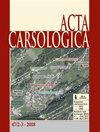Bat guano and historical evidence of climate changes in the west of Iran during the Late Holocene (Meghalayan Stage)
IF 1.1
4区 地球科学
Q4 GEOSCIENCES, MULTIDISCIPLINARY
引用次数: 2
Abstract
An 86 cm thick sequence of bat guano layers in the Kolatarika Cave in Kurdistan province in the west of Iran was analysed. The sequence was radiocarbon dated and covers an age of approximately 4060 years. The results of geochemical data, statistical studies, along with the investigation, analysis and explanation of historical sources indicate the presence of warm and dry climate conditions between ca 2100 BC and 800 CE. These were contemporaneous with the occurrence of periods of drought and famine during the Achaemenid and Sassanid empires, and might have been was one of the causes of their ‘collapse. The existence of humid climate conditions between 800 and 1450 AD was contemporaneous with the period of Medieval Climate Anomaly and the historically documented prosperity of farms and agriculture during the Seljuk dynasties, the Samanids, and the rise of rainfall and river floods during the period of the Abbasid caliphate. The presence of cold and humid climate conditions between ca 1600 and 1750 AD was consistent with the so-called Little Ice Age and the Maunder Minimum. After this period, the climate of this area changed to warm and dry which was contemporaneous with the occurrence of famine and subsequent droughts of the late Safavid and Qajar dynasties in Iran. Key words: palaeoclimate, geochemistry, Little Ice Age, Medieval Climate Anomaly, Kolatarika Cave, Iran. Poznoholocenske podnebne spremembe v zahodnem Iranu: analize netopirskega gvana in zgodovinskih dokumentov V clanku predstavimo analize 86 centimetrov debelega zaporedja plasti netopirskega gvana v jami Kolatarika v provinci Kurdistan, Zahodni Iran. Radiometricno ugotovljen starostni razpon gvana obsega zadnjih 4060 let. Statisticna obravnava geokemicnih analiz gvana in raziskava zgodovinskih virov kažeta na toplo in suho podnebje v obdobju 2100 pr. n. st. in 800 n. st. To sovpada s susami in lakoto v casu ahamenidskega in sasanidskega cesarstva, kar je bil najverjetneje tudi vzrok njunega propada. Analize gvana kažejo na vlažno podnebje med 800 n. st. in 1450 n. st., kar ustreza srednjeveski podnebni anomaliji in obdobju razvoja kmetijstva in blaginje v casu dinastij Seldžukov in Samanidov. Vlažno podnebje s padavinami je povzrocilo tudi poplavljanje rek v casu abasidskega kalifata. Hladno in vlažno obdobje med letoma 1600 in 1700 sovpada z malo ledeno dobo oziroma Maunderjevim minimumom. Po tem obdobju podnebje postane toplejse in bolj suho, kar spet sovpada z lakoto in susami v poznem obdobju safavidske in kadžarske dinastije v Iranu. Kljucne besede: paleoklima, geokemija, mala ledena doba, srednjeveska podnebna anomalija, jama Kolatarika, Iran.晚全新世(梅加拉亚期)伊朗西部蝙蝠粪与气候变化的历史证据
对伊朗西部库尔德斯坦省Kolatarika洞穴中86厘米厚的蝙蝠粪层序列进行了分析。该序列经过放射性碳年代测定,年龄约为4060年。地球化学数据、统计研究以及对历史来源的调查、分析和解释的结果表明,大约在公元前2100年至公元前800年之间存在温暖干燥的气候条件。这与阿契美尼德和萨珊帝国时期干旱和饥荒的发生是同时代的,可能是他们“崩溃”的原因之一。公元800年至1450年间潮湿气候条件的存在与中世纪气候异常时期、塞尔柱王朝时期农场和农业的繁荣、萨曼德王朝时期以及阿拔斯哈里发时期降雨和河流洪水的兴起是同时代的。公元1600年至1750年间,寒冷潮湿的气候条件与所谓的小冰河时代和蒙德极小期相一致。在这一时期之后,该地区的气候变为温暖干燥,这与伊朗萨非王朝和卡扎尔王朝后期饥荒和随后的干旱的发生是同一时期的。关键词:古气候,地球化学,小冰期,中世纪气候异常,科拉塔里卡洞穴,伊朗。伊朗西部晚全新世气候变化:蝙蝠粪和历史文献的分析本文对伊朗西部库尔德斯坦省Kolatarika洞穴中86厘米厚的蝙蝠粪层序列进行了分析。鸟粪的放射性年龄范围覆盖了过去4060年。对鸟粪地球化学分析的统计分析和对历史来源的调查表明,公元前2100年和公元前800年期间气候温暖干燥,与阿契美尼德帝国和萨珊帝国时期的怀疑和饥荒同时发生,这可能是他们崩溃的原因。对鸟粪的分析表明,公元800年至1450年间气候潮湿,这与中世纪的气候异常以及塞尔柱王朝和萨曼德王朝时期的农业发展和繁荣时期相对应。潮湿的气候和降雨也导致了阿拔斯哈里发时期的河流泛滥。1600年至1700年之间的寒冷潮湿时期恰逢小冰河时代或蒙德极小期。在这一时期之后,气候变得更加温暖和干燥,这再次与伊朗萨非王朝和卡德尔王朝后期的饥饿和寿司不谋而合。关键词:古气候,地球化学,小冰河时代,中世纪气候异常,科拉塔里卡洞穴,伊朗。
本文章由计算机程序翻译,如有差异,请以英文原文为准。
求助全文
约1分钟内获得全文
求助全文
来源期刊

Acta Carsologica
地学-地球科学综合
CiteScore
1.50
自引率
14.30%
发文量
0
审稿时长
>12 weeks
期刊介绍:
Karst areas occupy 10-20 % of ice-free land. Dissolution of rock by natural waters has given rise to specific landscape and underground. Karst surface features and caves have attracted man''s curiosity since the dawn of humanity and have been a focus to scientific studies since more than half of millennia.
Acta Carsologica publishes original research papers and reviews, letters, essays and reports covering topics related to specific of karst areas. These comprise, but are not limited to karst geology, hydrology, and geomorphology, speleology, hydrogeology, biospeleology and history of karst science.
 求助内容:
求助内容: 应助结果提醒方式:
应助结果提醒方式:


